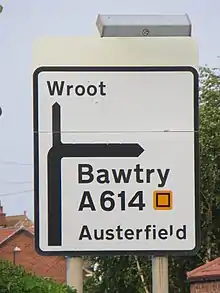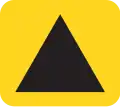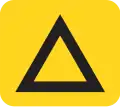Off-Network Tactical Diversion Route
In the United Kingdom, Emergency Diversion Routes are planned road traffic routes that bypass the main trunk road network.

Emergency Diversion routes provide the public, where possible, with a planned, checked and agreed junction to junction diversion route that circumnavigates an incident which has resulted in the closure of the main carriageway. In some other locations suitable diversion routes are not possible; this then requires the Highways Agency and its partners to implement alternative tactics such as strategic signs and signals. These are managed by the National Traffic Control Centre (NTCC).
Emergency diversion routes are marked with road signs in the form of simple geometric shapes - open and filled circles, squares, and diamonds.[1] Normally, these additions to roadsigns will be ignored by drivers.
When an incident closes a motorway or trunk road, police and Highways England Traffic Officers can activate 'trigger signs' at junctions before a closure advising traffic as to which symbol to follow around the incident along an alternative road and bring road users back onto the motorway or main road at a later junction beyond the closure.
The signs used for these routes can be found in the publication "Know your Traffic Signs".[2]
Emergency Diversion Route Symbols
Solid Versions
 Solid Circle
Solid Circle Solid Square
Solid Square Solid Triangle
Solid Triangle Solid Diamond
Solid Diamond
Hollow Versions
 Hollow Circle
Hollow Circle Hollow Square
Hollow Square Hollow Triangle
Hollow Triangle Hollow Diamond
Hollow Diamond
Related Signs
 Diversion trigger sign - The M1 Motorway is closed, follow the 'hollow diamond' diversion to arrive at back the M1 after closure.
Diversion trigger sign - The M1 Motorway is closed, follow the 'hollow diamond' diversion to arrive at back the M1 after closure.
References
- Marshall, Chris. "Emergency Diversion Routes". Roads.org.uk. Retrieved 19 October 2018.
- "Know your traffic signs , page 107" (PDF). Department for Transport. 2007.